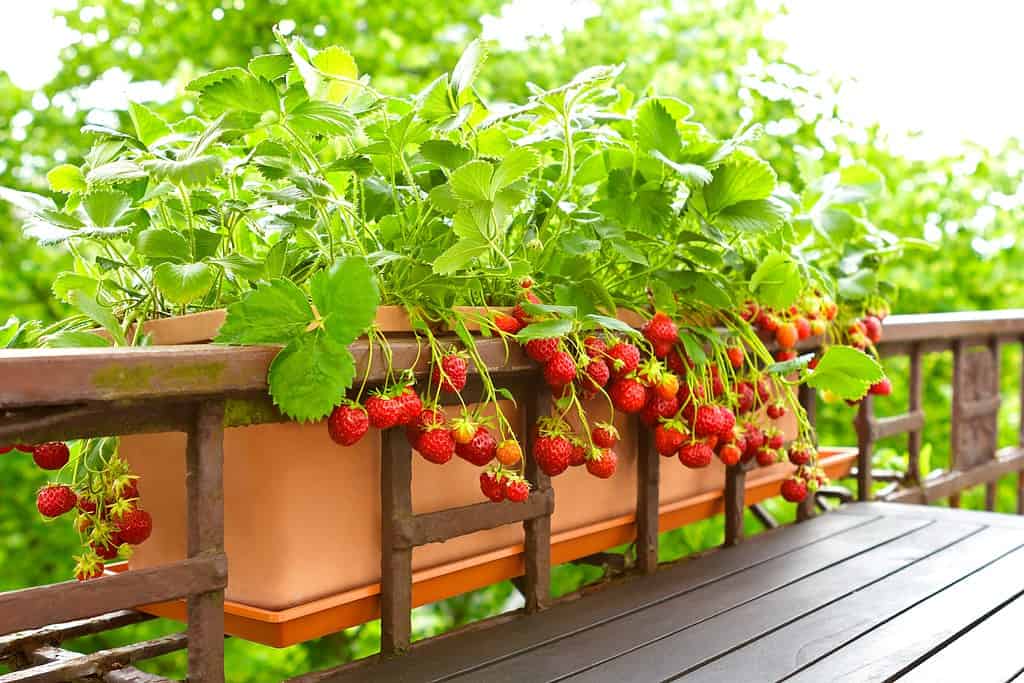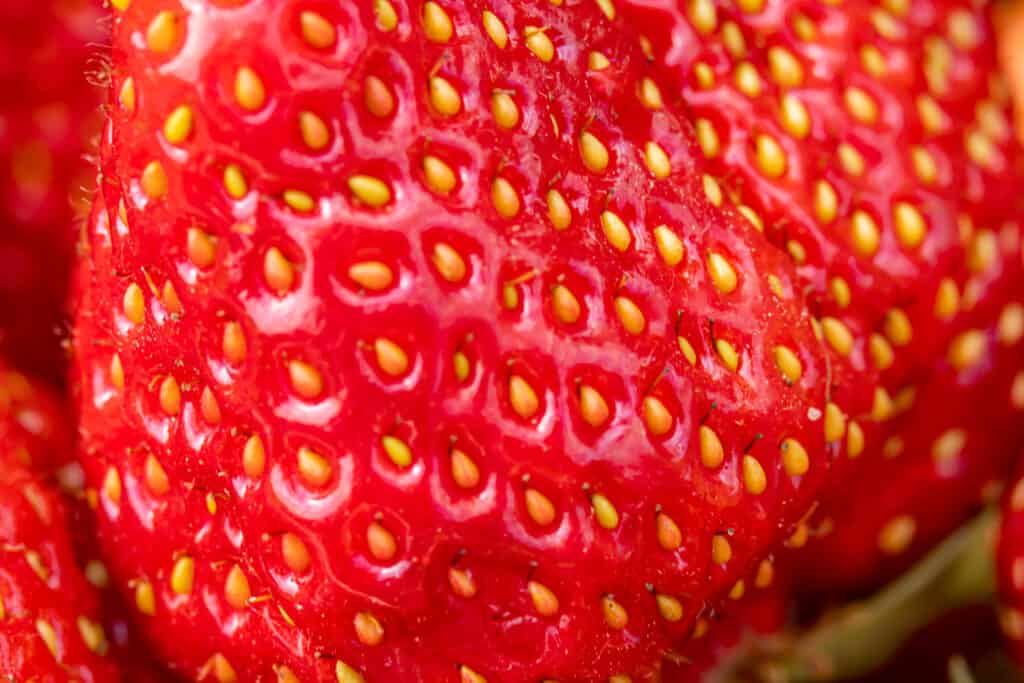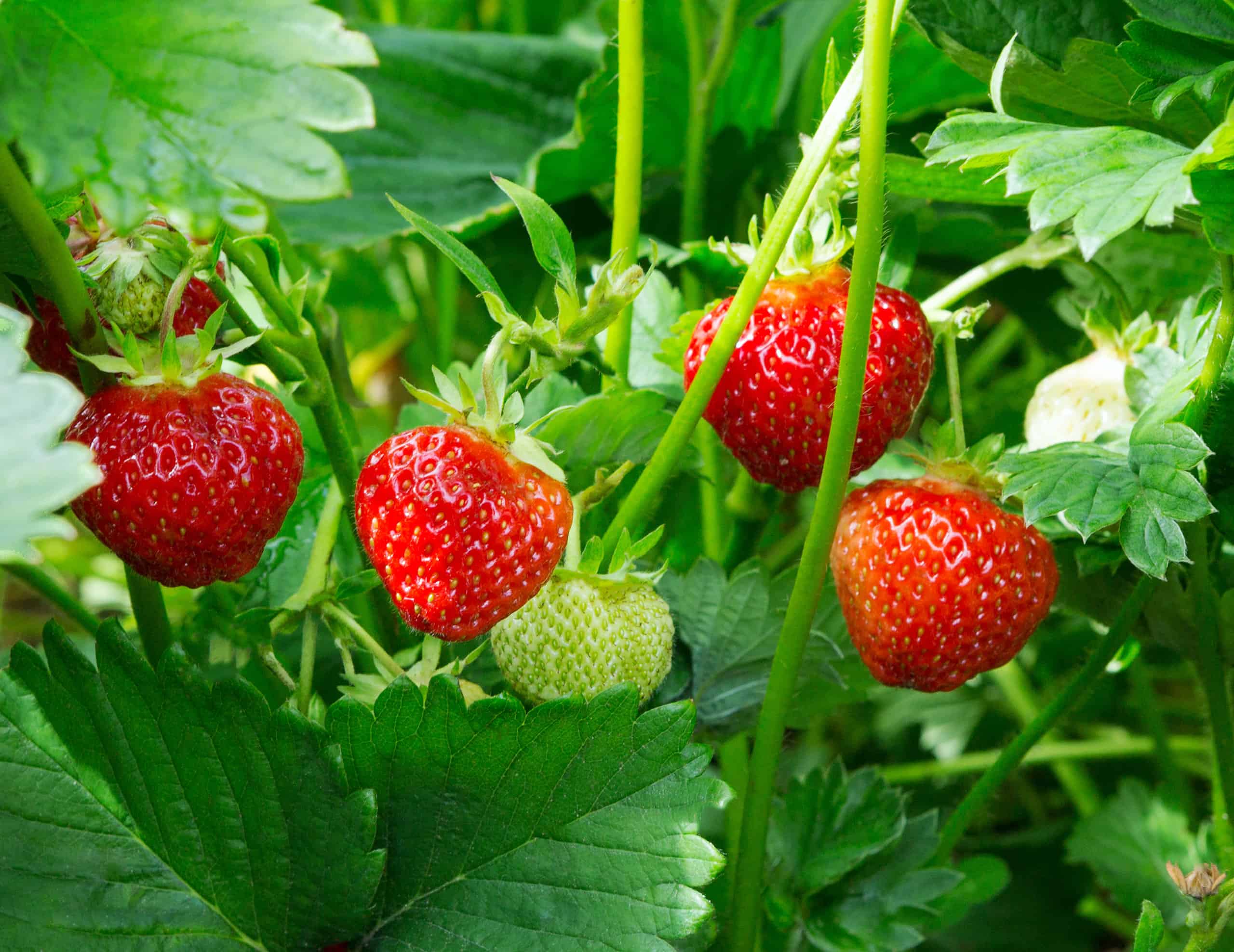Bursting with the sweet promise of summer, there’s no thrill quite like the first bite into a perfectly ripe Michigan strawberry. It’s a magical moment, a dance of flavor and fragrance, warmth and nostalgia. Now, you might be curious when exactly this berry good moment hits its zenith. Timing, my friend, is everything! It’s all about figuring out when the strawberry season in Michigan is.
Michigan, the “Great Lake State,” is famous for its agricultural wonders. Its chilly winters, warm summers, and fertile soils are a winning combination for many crops, but strawberries steal the show. There’s a magic window, a sweet spot on the calendar when these ruby-red fruits hit their stride. The question is, when is this peak time?
In this guide, we’ll break down everything you need to know about strawberry season in Michigan, plus some handy tips for growing your strawberries.
What are Strawberries?
Strawberries, scientifically classified as Fragaria × ananassa, are delicious fruits that offer numerous health benefits. These small, red gems are not only a treat for the taste buds but also a nutritional powerhouse.
Strawberries belong to the Rosaceae family and are classified as aggregate accessory fruit. Each strawberry is composed of multiple tiny fruits, known as achenes, embedded in the fleshy receptacle. This unique structure contributes to their distinctive texture and flavor.
When it comes to health benefits, strawberries are rich in antioxidants, vitamins, and minerals. They are an excellent source of vitamin C, which supports a healthy immune system and aids in collagen production. Strawberries also provide dietary fiber, which promotes digestive health, and contain folate, potassium, and manganese.
These vibrant fruits are known for their high antioxidant content, which helps protect the body against cellular damage caused by free radicals. Just as well, strawberries are low in calories and can be a nutritious addition to a balanced diet.

Strawberries are extremely nutritious and delicious!
©nadia_if/Shutterstock.com
Peak Timing for Starting Strawberries in Michigan
Starting from Seed
The optimal period for initiating strawberry seed planting in Michigan hinges upon a combination of climatic and environmental factors. Michigan’s geographical location is characterized by a temperate climate, with notable variations across the state. Consequently, the ideal time for sowing strawberry seeds varies depending on the specific region within Michigan.
In general, the peak timing to commence strawberry seed planting in Michigan falls between early spring and late spring, aligning with the average last frost date for each region. This ensures that the soil temperature remains above freezing and provides an adequate growth environment for the seeds. Engaging in seed planting too early may expose the seeds to the risk of frost damage, while planting too late may hinder their germination and subsequent growth.
To ascertain the precise optimal timing for strawberry seed planting, it is recommended to consult the Michigan State University Extension or the local agricultural extension office. These resources offer region-specific guidance, taking into account the climatic peculiarities of different areas within the state.
By adhering to the recommended planting schedule and providing proper care, aspiring strawberry growers can maximize their chances of yielding a bountiful harvest. However, it is crucial to remain vigilant of weather patterns and any unexpected fluctuations that may impact the growth and development of strawberry plants.
Starting from Transplants or Seedlings
Determining the prime period to commence planting strawberry transplants or seedlings in Michigan is contingent upon various factors that interplay harmoniously to ensure successful growth. The optimal timing for initiating this process may vary across Michigan due to its diverse climatic conditions.
For most regions in Michigan, the peak timing to start planting strawberry transplants or seedlings typically falls within the spring season. It is recommended to wait until the threat of frost has passed and the soil temperature has warmed adequately, usually around early to mid-spring. Planting too early can expose the delicate transplants to the risk of frost damage, while planting too late may hinder their establishment and growth.
To obtain precise guidance on the appropriate planting timing for strawberry transplants or seedlings in a specific Michigan region, it is advisable to seek advice from reliable sources such as the Michigan State University Extension or the local agricultural extension office. These organizations possess in-depth knowledge about the local climate and can offer tailored recommendations.
By adhering to the recommended planting schedule and providing proper care, aspiring strawberry growers can enhance the likelihood of achieving a fruitful harvest. Vigilance towards weather fluctuations and proactive measures to protect the plants from adverse conditions can contribute to the overall success of strawberry cultivation in Michigan.
Peak Timing for Harvesting Strawberries in Michigan
Determining the optimal time to begin harvesting strawberries in Michigan involves careful consideration of multiple factors that influence fruit ripening. The specific timing can vary depending on the strawberry variety, weather conditions, and regional variances within the state.
In general, the peak period for harvesting strawberries in Michigan occurs during the summer months, typically starting from late spring to early summer. This would be considered strawberry season in Michigan in general. However, it’s important to note that the exact timing may fluctuate based on the prevailing climate and local growing conditions.
To determine the ideal moment for strawberry harvesting, it is recommended to assess the fruit’s color and texture. Ripe strawberries exhibit vibrant red hues and a firm yet juicy texture. Additionally, their characteristic fragrance becomes more pronounced when they are fully ripe. It is advisable to gently lift the foliage to access the fruit and harvest the ripe berries carefully, leaving the unripe ones to continue maturing.
Regular monitoring of the strawberry plants is crucial to ensure that the fruits are harvested at the optimal time. Weather patterns, including temperature fluctuations and rainfall, can impact the ripening process. Therefore, it is essential to adapt the harvesting schedule accordingly.
By paying close attention to the fruit’s appearance, texture, and aroma, strawberry growers in Michigan can enjoy the delectable rewards of their labor during the prime harvesting season. Remember, patience and careful observation are key to capturing the peak flavors of Michigan-grown strawberries.

Growing strawberries at home in Michigan is not particularly difficult, whether you grow them from seed or transplants.
©Agenturfotografin/Shutterstock.com
Harvesting Locations in Michigan
When it comes to finding the best locations for strawberry harvesting in Michigan, the state offers a plethora of fruitful options. With its diverse agricultural landscape, Michigan boasts several regions renowned for its succulent strawberries.
Southwestern Michigan
One such prime strawberry-harvesting location is the southwestern part of the state, which benefits from its favorable climate and fertile soils. Areas like Berrien County, Van Buren County, and Allegan County are known for their thriving strawberry farms, attracting both locals and visitors alike.
Southeastern Michigan
Another noteworthy region for strawberry picking is the southeastern corner of Michigan, encompassing Monroe County and Lenawee County. These areas feature a mix of large-scale commercial farms and smaller family-owned operations, providing a range of options for strawberry enthusiasts.
North Michigan
Heading north, the Grand Traverse Bay area and the surrounding counties present delightful opportunities for strawberry harvesting. The cool climate and well-drained soils contribute to the cultivation of exceptionally sweet and flavorful berries.
Michigan’s Thumb
Michigan’s thumb region, including Huron County and Sanilac County, is yet another fantastic destination for strawberry lovers. The sandy loam soils and moderate temperatures in this area create an ideal environment for strawberry cultivation.
To make the most of the strawberry-harvesting experience, it is advisable to check local farm directories, websites, or social media pages for updates on harvest schedules and availability. Many farms offer the delightful experience of picking your strawberries, allowing you to enjoy the freshest berries straight from the field.
Whether you explore the southwestern, southeastern, northern, or thumb regions of Michigan, you’re bound to discover exceptional strawberry-harvesting locations that will satisfy your taste buds and create lasting memories.
Signs of Ready-to-Pick Strawberries
Recognizing the perfect moment to pluck a ripe strawberry from its plant requires attentive observation and a keen eye for certain signs. Understanding these indicators can ensure a delightful and flavorful strawberry-harvesting experience.
Color
First and foremost, the color of the strawberry serves as a vital clue. Ripe strawberries exhibit a vibrant red hue, signaling their readiness to be picked. Avoid strawberries that appear pale or green, as they are likely unripe and may lack sweetness.
Texture
The texture is another significant factor to consider. Gently touch the strawberry and assess its firmness. Ripe strawberries should feel plump and slightly yielding to the touch. A strawberry that feels excessively soft or mushy might be overripe or starting to spoil.
Fragrance
The fragrance also plays a role in determining ripeness. Ripe strawberries emit a delightful, sweet aroma that intensifies as they reach their peak. Take a moment to inhale the strawberry’s fragrance, and if it exudes a pleasant, fruity scent, it’s likely ready to be plucked.
Appearance
Lastly, examine the strawberry’s overall appearance. A ripe strawberry should have a glossy, smooth surface, free from blemishes or signs of decay. Inspect the calyx, the leafy green cap at the top of the strawberry, as it should be vibrant and fresh-looking.
By paying attention to these telltale signs of ripeness – vibrant color, firmness, fragrance, and appearance – strawberry enthusiasts can savor the juiciest and most flavorful berries during their harvest. Remember, a patient and observant approach will ensure that each picked strawberry is a delectable delight.
Tips for Harvesting Strawberries in Michigan
When it comes to harvesting strawberries in Michigan, employing a few helpful tips can ensure a fruitful and enjoyable experience. Whether you’re a seasoned picker or a novice, these suggestions will assist you in gathering the sweetest strawberries.
Harvest in the Morning
Firstly, it’s best to harvest strawberries in the morning when the temperatures are cooler. This not only helps preserve the fruit’s quality but also minimizes potential damage during handling. To harvest strawberries, grasp the fruit gently between your thumb and forefinger, taking care not to squeeze or bruise it. Give a slight twist, and the strawberry should detach easily from the stem.
Always Pick the Ripest Ones
It’s essential to be selective and only pick fully ripe strawberries. Look for berries that display a vibrant red color, indicating their maturity. Avoid green or unripe strawberries, as they may not reach their optimal sweetness. When picking, leave the green calyx, or cap, attached to the strawberry. Removing it can cause the fruit to spoil more quickly. Inspect the strawberry carefully before placing it in your container. Discard any damaged or moldy berries to prevent contamination and preserve the quality of the harvest. If you’re unsure about a strawberry’s ripeness, give it a gentle sniff. Ripe strawberries emit a sweet, fragrant aroma that can guide your selection.
Keep it Clean
Remember to bring a clean container with you to hold your harvest. A shallow container is preferable to avoid crushing the strawberries at the bottom.
By following these tips, you’ll be well-equipped to gather the ripest and most flavorful strawberries Michigan has to offer. Enjoy the delicious rewards of your labor and the satisfaction of hand-picking nature’s juicy gems!

The skin of a strawberry is a great indicator of its ripeness.
©iStock.com/Oleg Prolat
Tips and Tricks for Growing Your Strawberries in Michigan
For home gardeners looking to grow their strawberries in Michigan, a few helpful tips can set them on the path to success. With careful planning and proper care, you can enjoy the delectable taste of homegrown strawberries.
Choose the Right Strawberry Variety
Select a strawberry variety that is well-suited for Michigan’s climate. Some recommended varieties include Jewel, Honeoye, and Allstar. Consider factors such as disease resistance, yield, and flavor when making your choice.
Choose the Right Site
Find a sunny spot in your garden that receives at least six hours of direct sunlight each day. Ensure the soil is well-drained and rich in organic matter. If the soil is heavy clay, amend it with compost or peat moss to improve drainage.
Use the Right Planting Technique
Dig a hole deep and wide enough to accommodate the strawberry roots. Set the plants at the same depth they were previously grown, spreading the roots out. Space the plants about 12 to 18 inches apart to allow for adequate air circulation.
Watering and Mulching
Water your strawberries regularly to consistently keep the soil wet, especially during dry periods. Apply mulch around the plants to help retain moisture, suppress weeds, and prevent the berries from touching the soil.
Fertilization
Apply a balanced fertilizer, such as a 10-10-10 formula, according to the package instructions. Start fertilizing in early spring and continue throughout the growing season, but avoid over-fertilizing, as it can lead to excessive foliage growth and reduced fruit production.
Manage Weeds
Regularly remove weeds around the strawberry plants to prevent competition for nutrients and water. Be careful not to disturb the shallow strawberry roots while weeding.
Manage Pests and Diseases
Keep a lookout for common strawberry pests such as slugs, snails, and strawberry root weevils. Use organic pest control methods or consult with your local agricultural extension office for guidance. Monitor the plants for signs of diseases like powdery mildew or gray mold, and take appropriate action if necessary.
Harvest Smart
As the strawberries ripen, harvest them when they reach their full color and have a plump texture. Gently twist or cut the fruit from the plant, leaving the green cap intact. Enjoy the fruits of your labor promptly or preserve them by freezing or canning.
Remember, patience and attention to detail are key when growing strawberries during the strawberry season in Michigan. By following these tips and adapting them to your specific garden conditions, you can relish the joy of homegrown strawberries in Michigan. And if you don’t feel particularly compelled to grow your strawberries at home, the strawberry season in Michigan provides an excellent opportunity to go to your local U-pick farm and harvest your own!
Thank you for reading! Have some feedback for us? Contact the AZ Animals editorial team.








